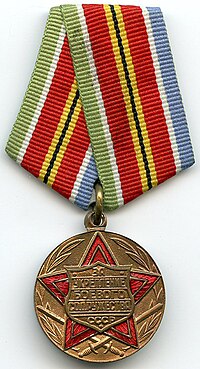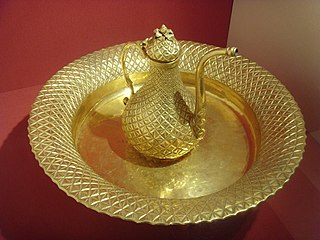
The Medal "For the Victory over Japan" was a campaign medal of the Soviet Union established on September 30, 1945 by decree of the Presidium of the Supreme Soviet of the Soviet Union to commemorate the Soviet victory over the Empire of Japan in the Soviet–Japanese War at the end of World War II. The medal's statute was later amended on July 18, 1980 by decree of the Presidium of the Supreme Soviet of the USSR № 2523-X.

The Medal "For Distinction in Guarding the State Border of the USSR" was a military decoration of the Soviet Union established to recognise outstanding deeds related to state frontier security by members of KGB border troops, servicemen and civilians.

The Medal "In Commemoration of the 800th Anniversary of Moscow" was a state commemorative medal of the Soviet Union established by decree of the Presidium of the Supreme Soviet of the USSR on September 20, 1947 and bestowed to prominent Soviet citizens and veterans in commemoration of the 800th anniversary of the first Russian reference to Moscow, dating to 1147 when Yuri Dolgorukiy called upon the prince of the Novgorod-Severski to "come to me, brother, to Moscow". Its statute was amended by decree of the Presidium of the Supreme Soviet of the USSR on July 17, 1980.

The Medal "Veteran of the Armed Forces of the USSR" was a long service award of the Armed Forces of the Soviet Union established on May 20, 1976 by decree of the Presidium of the Supreme Soviet of the USSR and awarded for twenty-five years of impeccable service to troops of the army, navy, of internal forces and of border troops. Its statute was twice amended by further decrees of the Presidium of the Supreme Soviet of the USSR, first on July 18, 1980 and lastly on January 10, 1984.

The Jubilee Medal "30 Years of the Soviet Army and Navy" was a state military commemorative medal of the Soviet Union established on February 22, 1948 by decree of the Presidium of the Supreme Soviet of the USSR to denote the thirtieth anniversary of the creation of the Soviet Armed Forces. Its statute was later amended by decree of the Presidium of the Supreme Soviet of the USSR of July 18, 1980.

The Jubilee Medal "40 Years of the Armed Forces of the USSR" was a state military commemorative medal of the Soviet Union established on December 18, 1957 by decree of the Presidium of the Supreme Soviet of the USSR to denote the fortieth anniversary of the creation of the Soviet Armed Forces. Its statute was later amended by decree of the Presidium of the Supreme Soviet of the USSR of July 18, 1980.

The Jubilee Medal "50 Years of the Armed Forces of the USSR" was a state military commemorative medal of the Soviet Union established on December 26, 1967 by decree of the Presidium of the Supreme Soviet of the USSR to denote the fiftieth anniversary of the creation of the Soviet Armed Forces. Its statute was amended on three separate occasions, by decrees of the Presidium of the Supreme Soviet of the USSR of February 22, 1968., of December 19, 1969, and of July 18, 1980.

The Jubilee Medal "60 Years of the Armed Forces of the USSR" was a state military commemorative medal of the Soviet Union established and bestowed to military personnel to denote the sixtieth anniversary of the creation of the armed forces of the Soviet Union. It was established on January 28, 1978 by decree of the Presidium of the Supreme Soviet of the USSR. Its statute was amended by decree of the Presidium of the Supreme Soviet of the USSR on July 18, 1980.

The Jubilee Medal "70 Years of the Armed Forces of the USSR" was a state military commemorative medal of the Soviet Union established on January 28, 1988 by decree of the Presidium of the Supreme Soviet of the USSR to denote the seventieth anniversary of the creation of the Soviet Armed Forces.
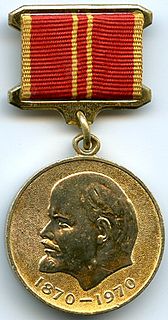
The Jubilee Medal "In Commemoration of the 100th Anniversary of the Birth of Vladimir Ilyich Lenin" was a state commemorative medal of the Soviet Union established by decree of the Presidium of the Supreme Soviet on November 5, 1969 to commemorate the 100th anniversary of the birth of Vladimir Lenin. Its statute was amended on July 18, 1980 by decree of the Presidium of the Supreme Soviet. It was awarded to eminent members of Soviet society, the military leadership and foreign members of the international communist and labour movements.

The Medal "For the Defence of Leningrad" was a World War II campaign medal of the Soviet Union established on December 22, 1942 by decree of the Presidium of the Supreme Soviet of the USSR to recognise the valour and hard work of the Soviet civilian and military defenders of Leningrad during the 872-day siege of the city by the German armed forces between September 8, 1941 and January 27, 1944. The medal's statute was later amended by Resolution of the Presidium of the Supreme Soviet on March 8, 1945. and again one last time on July 18, 1980 by decree of the Presidium of the Supreme Soviet of the USSR № 2523-X.

The Medal "For the Defence of Odessa" was a World War II campaign medal of the Soviet Union established on December 22, 1942 by decree of the Presidium of the Supreme Soviet of the USSR to reward the participants of the defence of the port city of Odessa from the armed forces of NAZI Germany. The medal's statute was amended on July 18, 1980 by decree of the Presidium of the Supreme Soviet of the USSR № 2523-X.
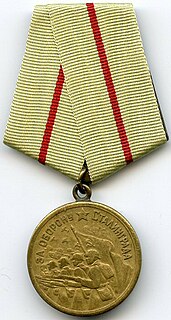
The Medal "For the Defence of Stalingrad" was a World War II campaign medal of the Soviet Union.
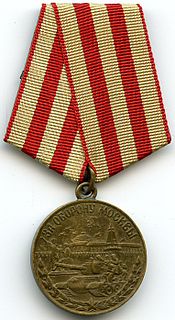
For the Defense of Moscow was a World War II campaign medal of the Soviet Union awarded to military and civilians who had participated in the Battle of Moscow.

The Medal "For the Capture of Berlin" was a World War II campaign medal of the Soviet Union established on June 9, 1945 by decree of the Presidium of the Supreme Soviet of the USSR to satisfy the petition of the People's Commissariat for Defense of the Soviet Union. The medal's statute was amended on July 18, 1980 by decree of the Presidium of the Supreme Soviet of the USSR № 2523-X.
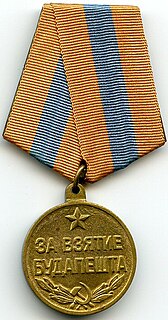
The Medal "For the Capture of Budapest" was a World War II campaign medal of the Soviet Union established on 9 June 1945 by decree of the Presidium of the Supreme Soviet of the USSR to satisfy the petition of the People's Commissariat for Defense of the Soviet Union to recognise and reward the participants of the battle for the capture of the city of Budapest from the armed forces of Nazi Germany. The medal's statute was amended on 18 July 1980 by decree of the Presidium of the Supreme Soviet of the USSR № 2523-X.

The Medal "For the Capture of Königsberg" was a World War II campaign medal of the Soviet Union established on June 9, 1945 by decree of the Presidium of the Supreme Soviet of the USSR to satisfy the petition of the People's Commissariat for Defense of the Soviet Union for recognition of the participants of the battle to capture the city of Königsberg from the armed forces of Nazi Germany. The medal's statute was amended on July 18, 1980 by decree of the Presidium of the Supreme Soviet of the USSR № 2523-X.

The Medal "For the Capture of Vienna" was a World War II campaign medal of the Soviet Union established on June 9, 1945 by decree of the Presidium of the Supreme Soviet of the USSR to satisfy the petition of the People's Commissariat for Defense of the Soviet Union to reward the participants of the battles for the capture of the city of Vienna from the armed forces of Nazi Germany. The medal's statute was amended on July 18, 1980 by decree of the Presidium of the Supreme Soviet of the USSR № 2523-X.

The Medal "For the Liberation of Prague" was a World War II campaign medal of the Soviet Union established on June 9, 1945 by decree of the Presidium of the Supreme Soviet of the USSR to satisfy the petition of the People's Commissariat for Defence of the Soviet Union to adequately reward the participants of the battles for the liberation of the city of Prague from the armed forces of Nazi Germany.

The Medal "For the Liberation of Warsaw" was a World War II campaign medal of the Soviet Union established on June 9, 1945 by decree of the Presidium of the Supreme Soviet of the USSR to satisfy the petition of the People's Commissariat for Defence of the Soviet Union.





